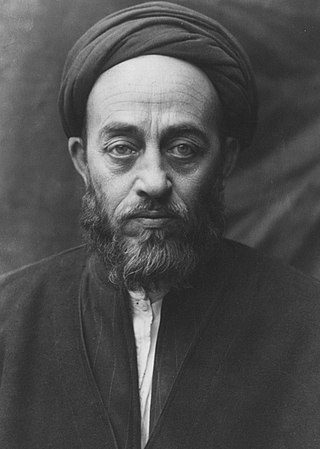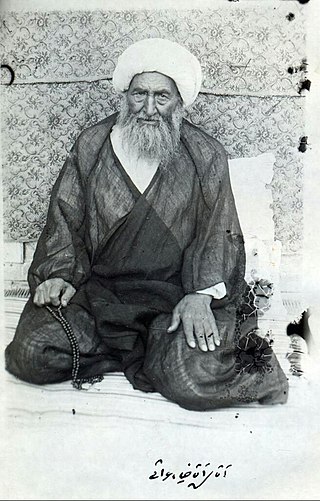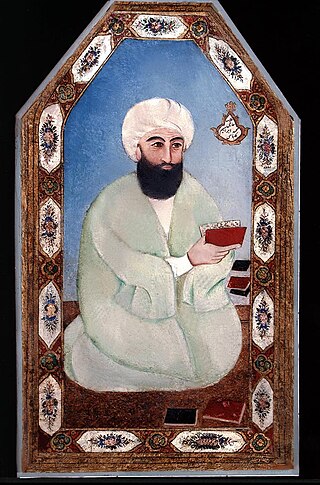Seghatoleslam, also spelled Seqat-ol-eslam, or Thiqat ul-Islam, is an honorific title within the Twelver Shia clergy. Historically, it denoted a scholar who had completed a certain level of religious education but had not yet attained the highest authority in the religious hierarchy, known as Ayatollah . [1] In the recent past, it was typically conferred upon individuals who had completed Islamic seminary levels 1 and 2, obtaining a degree in Islamic jurisprudence (Fiqh) and theology (Usul al-din). [2] The title also signifies a trustworthy person respected by Muslims, reflecting a specific level of seminary knowledge. [3] [4]
The term Seghatoleslam [ Persian: ثقت الاسلام], [ Arabic: ثقة الاسلام] is derived from two Arabic words: ثقة, meaning trustworthy, and Islam [ Arabic: اسلام] referring to the Islam's religion. Consequently, the title can be translated as Trustworthy of Islam . [5] [6] [7]
In Usulist, a branch of Islamic Biographical Evaluation, there is issuing a fatwa is only permissible by trusting the words of authenticated narrators, and Seghatoleslam designates narrators whose justice and trustworthiness have been explicitly verified. [8]
In Shia Islam, Seghatoleslam was historically viewed as a precursor to the higher title of Ayatollah, [1] as achieving Ayatollah status required additional years of study and research beyond the Seghatoleslam degree. [9]
Although the majority of Iran's population is Shia Muslim, the use of the title Seghatoleslam is not widespread in Iran. It was, however, utilised in other countries with substantial Shia Muslim populations, such as Iraq. [10] [11]
It is essential to note that the application of religious titles in Shia Islam is not uniform, and variations exist in how these titles are employed and understood in different contexts.
The title Seghatoleslam was initially used for Muhammad ibn Yaqub al-Kulayni (864 -941), [12] [13] the compiler of al-Kaafi. According to Mudir Shanachi , "al-Kulayni was known as Seghatoleslam in his time". [14]
The conceptual evolution of titles for Shia Islam clerics in Iran has changed over time. Seghatoleslam, once used for the students in preliminary stages, was previously the title of eminent scholars. [15] Some titles, like Grand Ayatollah , became prevalent and are exclusively applied to Maraji, meaning religious scholars who are references for others. At different times, the title Akhund , was used for great scholars such as Akhund Molla Mohammad Kazim Khurasani or Akhund Molla Mohammad Baqer Majlesi . [16] These titles in seminaries are conventional, without a specific institution awarding them. [17]
In the past, Seghatoleslam referred to scholars at level 1 and 2. [18] Presently, the primary objective of the level 1 and 2 courses is to teach Arabic literature, including grammar, semantics, eloquence. Students are also familiarised with basic subjects such as Logic and Jurisprudence, usually from the books like Jame-ol Moghaddamat, [19] al-Mughni, and Suyuti. [3]
The duration of the taught course typically spans three years for the Arabic literature course, along with an addition three years for the Logic and Jurisprudence courses. [4]
In earlier times, Seghatoleslam was a title bestowed upon distinguished scholars, such as Sheikh Muhammad ibn Yaqub al-Kulayni or Sheikh al-Saduq. [12] [13] However, this title is not presently used in seminaries in Iran. [18]
Hujjatoleslam refers to students at level 3. During this stage, books like Mo'alem al-Usul [20] or Usul al-Istinbat, [21] Al-Mujaz, [22] Usul al-Fiqh Muzafar, [23] Rasa'il, [24] and Kafiya tol-Usul [25] are usually taught. Additionally, Jurisprudence books such as Sharh Lom-e [26] and Makaseb are included in the curriculum. [3]
The duration of the taught course typically spans four years. [4]
Upon entering the next stage (advanced level 4) and reaching the kharej (advanced courses of the seminary) study level, students are conferred the title Hujjatoleslam Wal-Muslemin. This stage is regarded as the highest course of seminary courses, aiming to produce mujtahids in the fields of Islamic jurisprudence (Fiqh) or theology (Usul al-din). The goal is to develop the ability to derive rulings from authentic sources [books [27] (Qur'an ic sciences), Sunnah, wisdom, and consensus]. This stage usually does not rely on specific textbooks but is structured around the sufficiency of principles in Jurisprudence and Jawaher al-Kalam, [28] Tahrir al-Wasila, and Urwa tol-Wosgha [29] in Jurisprudence. It is essentially a research-oriented course. [3]
The taught course at this stage typically lasts a minimum of four years. [4]
In the past, the title Hujjatoleslam Wal-Muslemin was used for Maraji, such as the Risalah of the late Ayatollah Hossein Borujerdi was published under the title Hujjatoleslam Wal-Muslemin Hossein Borujerdi , or, for example, Muhammad al-Ghazali, had this title in the past. [30] However, today these titles hold a different meaning.
Ayatollah refers to an individual who has successfully completed the kharej course (advanced courses of the seminary) and reached the level of Ijtihad. Ijtihad implies the ability to independently derive rulings using legal and principled evidence and foundations. [3]
There are two types of mujtahids: the bounded mujtahid, who is proficient in specific chapters of Fiqh, and the absolute mujtahid, who is proficient in all chapters of Fiqh. [31]
Apart from completing advanced studies, an individual must teach a kharej course (advanced courses of the seminary) of Islamic jurisprudence (Fiqh) or theology (Usul al-din) for several years to attain the title of Ayatollah.
While Seghatoleslam is primarily a title in Shia Islam, [32] it can also be used as a family name in some Iranian families. This practice aligns with the common cultural phenomenon where individuals use titles as family names or adopt religious or cultural terms reflecting their identity as their family name. [7] [33]
The utilisation of Seghatoleslam as a family name is relatively uncommon and mostly confined to Iran / Persia. In other countries, even those with significant Shia Muslim populations, [10] [11] people tend to adopt other family names that mirror their cultural or ethnic identity. [34]
Individuals with the Seghatoleslam family name may be residing in Shiraz, Tabriz, or other parts of Iran / Persia, considering it is a distinct family name in the region. Notable family members in Iran include:
A hawza or ḥawzah ʿilmīyah is the collective term for madrasa where Shi'a Muslim scholars are educated.

Muhammad Husayn Tabataba'i was an Iranian scholar, theorist, philosopher and one of the most prominent thinkers of modern Shia Islam. He is perhaps best known for his Tafsir al-Mizan, a twenty-seven-volume work of tafsir, which he produced between 1954 and 1972. He is commonly known as Allameh Tabataba'i and the Allameh Tabataba'i University in Tehran is named after him.

Zia'eddin Araghi also known as Agha Zia'eddin Araghi was an eminent Shia jurist, Usuli and Mujtahid during the flourishing the Usul Fiqh in Ja'fari school in Shia after Muhammad Baqir Behbahani.
Sallar Deylami is one of the first Iranian Shia jurists during the fifth century of the Islamic calendar. He is considered a jurist of the class of Shaykh Tusi.

Mehdi Shabzendedar Jahromi is an Iranian Shia jurist and member of the Guardian Council."

The Najaf Seminary, also known as the al-Hawza Al-Ilmiyya, is the oldest and one of the most important Shia seminaries (hawza) in the world. It is located near the Imam Ali Shrine in the city of Najaf in Iraq, and also operates a campus in Karbala, Iraq. It was established by Shaykh al-Tusi, and continued as a center of study after the establishment of modern Iraq in 1921.

Seyyed Mohammad Hojjat Kooh Kamari was a contemporary Iranian Muslim Faqīh and a Twelver Marja' who was in charge of the administration of the Qom Seminary for ten years. He was born on 17 March 1893 and died on 19 January 1953. He was a prominent student of Abdul-Karim Haeri Yazdi and after him held the position of Shia authority.
Alireza Feyz was an Iranian author, researcher of Islamic jurisprudence and Islamic philosophy, professor at the University of Tehran and jurist.

Seyed Abolfazl Rihani, known as Ayatollah Seyed Abolfazl Mousavi Tabrizi. He was a member of the Assembly of Experts, was involved with the creation of the Constitution of the Islamic Republic of Iran being a member of the Assembly of Experts for Constitution, and was the Prosecutor-General of Iran.
Mirza Abolghasem Gilani, known as Mirza-ye Qomi, the author of the book of Qawanin al-Usul, was a Shiite jurist (Faqīh), mujtahid, fundamentalist (Usuli) and a religious reference (Marja') during the reign of Fath Ali Shah Qajar in the twelfth century AH. Mirza-ye Qomi was active and famous in poetry and calligraphy. He has left more than fifty thousand verses of poetry in Persian and Arabic, as well as writings in Naskh and Nastaliq scripts.

Grand Ayatollah Sheikh Mohammad Ibrahim al-Karbasi (kalbasi) known as Sahib al-Isharat was a Shia jurist, mujtahid, fundamentalist, Quran commentator, theologian, scholar of biographical evaluation and marja', and considered the reviver of the Isfahan Seminary in the 19th century.

Seyyed Abdollah Fateminia was an Iranian Shiite cleric, professor of Islamic ethics, orator, Islamic historian and bibliographer. He researched Arabic poetry, hadith, ethics and mysticism. His religious sermons were often broadcast on Iranian television, so he was a well-known religious figure in Iran.

Seyed Reza Bahaadini was an Iranian Shia jurist, teacher of ethics and practical mysticism. He was one of the disciples of Abdul-Karim Haeri Yazdi, Seyyed Mohammad Hojjat Kooh Kamari, Seyyed Mohammad Taghi Khansari and Hossein Borujerdi. His greatest occupation and fame was his public or private debates on Islamic ethics courses, which lasted until the last days of his life.

Mirza Jawad Agha Maleki Tabrizi or Mirza Jawad Maleki Tabrizi was a scholar of Islamic jurisprudence, principles, ethics, wisdom and Islamic mysticism.
Sheikh Hadi Rohani was an Iranian ayatollah. He represented the Supreme Leader of Iran for Mazandaran Province, as well as being the Friday Prayer Leader for Mazandaran. He also represented the people in Mazandaran for the first, second and third terms of the Assembly of Experts.

Sheikh Nasrallah Shah-Abadi Persian: شیخ نصرالله شاه آبادی, was an Iranian Ayatollah. He represented the people of Tehran Province in the Fifth term of the Assembly of Experts.

Sheikh Ahmad Beheshti Persian: شیخ احمد بهشتی, is an Iranian Ayatollah. He was the president of Qom University. He represented the people of Fars Province in the first and second terms in the Islamic Consultative Assembly, as well as the third, fourth, and fifth terms of the Assembly of Experts.

Sheikh Ali Akbar Masoudi Khomeini Persian: شیخ علیاکبر مسعودی خمینی, born 1932) is an Iranian ayatollah. He is a member of the Society of Seminary Teachers of Qom, as well as serving as the Trustee for Fatima Masumeh Shrine.

Ali Karimi Jahromi Persian: علی کریمی جهرمی, is an Iranian Grand Ayatollah. He currently teaches in Qom Seminary, and has attained Ijtihad from Seyed Mohammad Reza Golpaygani, Seyed Shahab ud-Din Mar'ashi Najafi, and Mohammad Ali Araki.

Seyed Hassan Mortazavi Shahroudi Persian: سید حسن مرتضوی شاهرودی, is an Iranian Ayatollah. He currently teaches Fiqh in Darse Khariji levels in Mashhad Islamic Seminary, and was one of the students of Ruhollah Khomeini in Najaf.